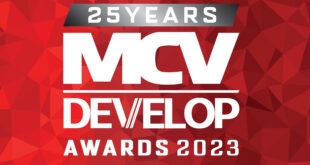The recent uproar around the cloning of Vlambeer’s next game, Luftrausers, has been picked up by every major gaming publication, with both Vlambeer and RubiqLabs, the developers of Luftrausers’s supposed clone (SkyFar), making themselves heard on the matter.
Most of us haven’t played Luftrausers; while it has been showcased at events, the game hasn’t been released yet, and while SkyFar is available for purchase on the App Store, most of the noise that’s been made about this controversy has been based on gameplay videos and side-by-side comparisons.
It would seem then that most of the outrage is due to how similar the two aerial combat games look; the same colour palette, an identical art style, and similar looking gameplay. Unlike SkyFar, Luftrausers won’t be on iOS; it’s a PC/Mac and console game, and so you’d expect far deeper gameplay mechanics than a touch interface would afford.
So it would appear that SkyFar is a strikingly similar looking game that plays nothing like Luftrausers will. That said, if the intention was to clone it to simply to cash in on the hype and not to actually replicate the gameplay experience, the visuals alone would probably achieve that.
It does beg the question though – How far is too far; where do you draw the line between drawing inspiration from a game and cloning it?
SkyFar probably is the clone that we’re all making it out to be, but it doesn’t take a lot these days for a game to be vilified simply on the basis of how similar it looks to another game.
This is something that a lot of up and coming indie developers have had to face of late. Possibly last year’s most notable game release out of India – Yellow Monkey Studio’s HUEBRIX, was also on the receiving end of such accusations.
HUEBRIX-Puzzlejuice
HUEBRIX earnedpraise for its devious puzzles and clever mechanics, but not all feedback was positive. The game’s minimalist art style was pulled up for bearing a striking resemblance to another puzzle game – Puzzlejuice.
I think with HUEBRIX, it was more the borrowing of visual elements than gameplay,” says Yellow Monkey Studios co-founder Krishna Israney. Having played games all my life, I knew we had something unique with HUEBRIX, but the accusations of borrowing visual elements are a bit tricky.”
While we have nothing but respect for the creators of Puzzlejuice, we had arrived to the visuals of HUEBRIX through our own trials and tribulations and we even cleared it out with the developers (of Puzzlejuice) themselves,” adds co-founder Shailesh Prabhu.
Those weren’t just random accusations being made on forums or social media. The similarities to Puzzlejuice’s art style also came up in reviews on sites like Touch Arcade. It’s the sort of bad press that can hurt a developer’s reputation and the game’s sales.
We did our best to make the colours such that they would have high contrast against a background as well as clear readability. Unfortunately, we don’t make fonts; we just buy the license so the elements felt ‘borrowed’. Once we had decided not to go with characters, we just wanted a flat design that would look good,” clarifies Israney.
Circulets-O
Delhi-based Hashstash Studios has found itself in a similar predicament. It is alsofacing accusationsthat its new same-screen multiplayer game, Circulets, bears more than a passing resemblance to iPad game, O.
Some of these people were already claiming that we stole the game and were asking the original developer – Michael Brough, to respond to the allegations,” says Hashstash founder Kinshuk Sunil.
We did not know about O. We hadn’t seen the game. We had done no research about a similar game existing before jumping into developing Circulets. It was like the beginning of a nightmare, where we would be branded as rip-offs,” Kinshuk added.
Circulets and O seem similar because both involve two players playing on the same device, and the core mechanic is to collect coloured circles to score points. However, what we think is (we haven’t played O yet) that O asks players to think about their moves and reach a definite end (an end score, whoever reaches first wins). In Circulets, there is no such competition. More than a game, Circulets is a toy – an electronic toy,” says Kinshuk.
Circulets
Fortunately for Hashstash, along with the accusations also came inputs from other indie developers who suggested that Circulets may not be the clone it was made out to be.
Meanwhile, the developer (of O) asked us if we had been influenced by it and we said that we had not. In time, he agreed that the two games were similar in some ways, but Circulets was not a clone,” said Kinshuk.
Brough’s clarificationwas once again vital in settling the issue as Circulets was dragged into the cloning debate once again after its release. This time, it was high-profile indie developer Adam Saltsman questioning the game’s originality.
Saltsman’s comments came shortly after Circulets was featured on IndieGames.com, which got the game a lot of exposure in a very short time. While the Canabalt developer later agreed, after clarification from Brough, that Circulets wasn’t a clone, the damage had already been done.
Saltsman’s words carried enough weight to prompt IndieGames.com to take its feature down, taking away the exposure, and perhaps sales, that Circulets may have received from the coverage.
Being featured on IndieGames.com wasn’t about sales or visibility, but it was an achievement for us as a game developer to have created a game worthy of being featured there,” said Kinshuk.
Developer Adam "Atomic" Saltsmans comments on Circulets
The feature being taken down sent the wrong message and made us look like the guilty party. Our game bears only a visual similarity to O; beyond that, the two are very different games. And after the feature was taken down, there was no medium available for us to clarify our position and we received no audience from IndieGames,” he added.
IndieGames confirmed to Hashstash that the feature was indeed taken offline because it appeared similar to O, which the site had featured months earlier.
Drawing the line
In the case of Circulets and O, both developers agreed that Circulets wasn’t a clone, and those that did question the originality of Circulets, clearly hadn’t played both games. So do visual similarities carry that much weight that a game could be labelled a clone simply based on its aesthetics and how its gameplay appears? Indeed, new games that lift gameplay mechanics from more popular gamesregularly appear on app stores, but those games don’t get nearly as much negative attention as those that look similar.
So where do you draw the line between drawing insp

 MCV/DEVELOP News, events, research and jobs from the games industry
MCV/DEVELOP News, events, research and jobs from the games industry



